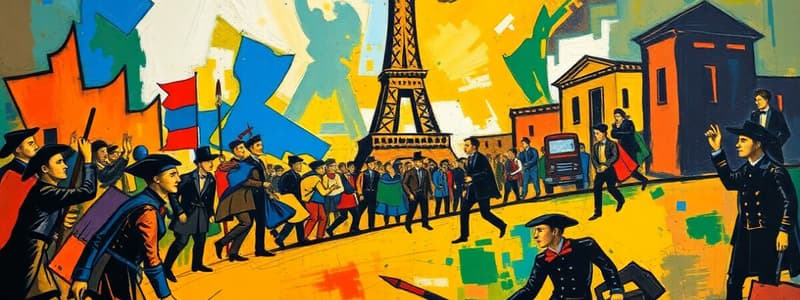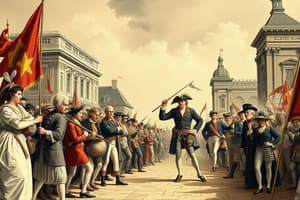Podcast
Questions and Answers
What percentage of the population did the rich nobles represent in the Second Estate?
What percentage of the population did the rich nobles represent in the Second Estate?
- 1 percent
- 2 percent (correct)
- 10 percent
- 5 percent
Which group within the Third Estate consisted of urban workers and was the poorest?
Which group within the Third Estate consisted of urban workers and was the poorest?
- Urban workers (correct)
- Clergy
- Bourgeoisie
- Nobility
What was a primary belief of the bourgeoisie in the Third Estate?
What was a primary belief of the bourgeoisie in the Third Estate?
- Enlightenment ideals of liberty and equality were essential. (correct)
- Social status should be based on land ownership.
- They should not pay taxes at all.
- Their wealth should exempt them from governmental oversight.
How much land did the nobles in the Second Estate own compared to the population they represented?
How much land did the nobles in the Second Estate own compared to the population they represented?
Which of the following statements about the clergy and nobility's view towards Enlightenment ideas is correct?
Which of the following statements about the clergy and nobility's view towards Enlightenment ideas is correct?
What major issue contributed to the social unrest in France leading to the Revolution?
What major issue contributed to the social unrest in France leading to the Revolution?
Which group within the Old Regime was granted exemptions from taxes?
Which group within the Old Regime was granted exemptions from taxes?
Which Enlightenment thinkers' ideas contributed to the questioning of the Old Regime?
Which Enlightenment thinkers' ideas contributed to the questioning of the Old Regime?
Which of the following did NOT contribute to the economic conditions leading to the French Revolution?
Which of the following did NOT contribute to the economic conditions leading to the French Revolution?
What was the dominant social structure in France prior to the Revolution?
What was the dominant social structure in France prior to the Revolution?
Which group represented the majority of the population in France in 1787?
Which group represented the majority of the population in France in 1787?
What was a common characteristic of the First Estate's view on the Enlightenment?
What was a common characteristic of the First Estate's view on the Enlightenment?
How did the Second Estate's view on Enlightenment ideas differ from the First Estate's view?
How did the Second Estate's view on Enlightenment ideas differ from the First Estate's view?
Which group had the least amount of power to influence the government?
Which group had the least amount of power to influence the government?
What percentage of income was typically paid in taxes by the Third Estate?
What percentage of income was typically paid in taxes by the Third Estate?
What caused the social unrest in France during the late 1700s?
What caused the social unrest in France during the late 1700s?
How were the social classes structured in the Old Regime of France?
How were the social classes structured in the Old Regime of France?
What role did Enlightenment thinkers play in the French Revolution?
What role did Enlightenment thinkers play in the French Revolution?
What was a major privilege held by the First and Second Estates?
What was a major privilege held by the First and Second Estates?
What factors contributed to the perception of France as a prosperous nation despite underlying issues?
What factors contributed to the perception of France as a prosperous nation despite underlying issues?
Flashcards
Old Regime in France
Old Regime in France
The social and political system of France in the 1770s, with three estates (social classes).
Privileged Estates
Privileged Estates
The First and Second Estates in France, who had high status, important positions, and tax exemptions.
First Estate
First Estate
The Roman Catholic clergy in France, owning 10% of the land.
Economic and Social Inequalities
Economic and Social Inequalities
Signup and view all the flashcards
French Revolution Causes
French Revolution Causes
Signup and view all the flashcards
Second Estate
Second Estate
Signup and view all the flashcards
Bourgeoisie
Bourgeoisie
Signup and view all the flashcards
Third Estate
Third Estate
Signup and view all the flashcards
Clergy
Clergy
Signup and view all the flashcards
Enlightenment Ideals
Enlightenment Ideals
Signup and view all the flashcards
Peasant Farmers
Peasant Farmers
Signup and view all the flashcards
Resentment towards Privileged Estates
Resentment towards Privileged Estates
Signup and view all the flashcards
Old Regime
Old Regime
Signup and view all the flashcards
Estates-General
Estates-General
Signup and view all the flashcards
Tennis Court Oath
Tennis Court Oath
Signup and view all the flashcards
Great Fear
Great Fear
Signup and view all the flashcards
National Assembly
National Assembly
Signup and view all the flashcards
Study Notes
The French Revolution
- Economic Inequality: Social and economic disparities in the Old Regime (pre-revolutionary France) fueled the French Revolution.
- Old Regime: France's social structure comprised three estates: the First Estate (clergy), Second Estate (nobles), and Third Estate (everyone else).
- First Estate: The clergy, who owned 10% of the land, paid little tax.
- Second Estate: The nobles, who owned 20% of the land, paid almost no tax.
- Third Estate: The majority (97%) of the population, including the bourgeoisie (middle class), urban workers, and peasants. They were heavily taxed and had little power.
- Bourgeoisie: Were bankers, factory owners, merchants, and skilled artisans who were well-educated. They embraced Enlightenment ideas and resented their lack of privileges.
- Urban Workers: Tradespeople, apprentices, laborers, and domestic servants who were paid low wages and often unemployed. They were heavily impacted by rising bread prices.
- Peasants: Formed the largest group in the Third Estate and bore a substantial tax burden.
- Enlightenment Ideas: Ideas of Locke, Rousseau, and Voltaire influenced revolution by emphasizing liberty, equality, and popular sovereignty.
- Economic Troubles: Bad harvests, high bread prices, and government debt contributed to the unrest.
- Weak Leadership: Louis XVI's indecisiveness and Marie Antoinette's unpopularity further exacerbated the situation.
- Estates-General: Assembly of representatives from the three estates, convened in 1789 to address the financial crisis.
- National Assembly: The Third Estate declared itself the National Assembly in 1789.
- Tennis Court Oath: Representatives of the Third Estate vowed to continue meeting until a new constitution was established.
- Bastille: A Paris prison, stormed by the people on July 14, 1789, signifying the start of the Revolution.
- Great Fear: Widespread peasant uprisings and violence in the countryside.
- Declaration of the Rights of Man and of the Citizen: A document outlining revolutionary ideals, emphasizing liberty, equality, and popular sovereignty.
- Limited Monarchy: A new constitution in 1791 established a limited monarchy, restricting the king's power.
- Divisions: The assembly split into factions (radicals, moderates, and conservatives) differing on the pace and nature of change.
- War: France went to war with Austria and Prussia.
Revolution Brings Reform and Terror
- Legislative Assembly: Replaced the National Assembly in 1791.
- Émigrés: Nobles and others who fled France.
- Sans-culottes: The Parisian workers, who called for more radical change.
- Jacobins: A radical political club that gained power and initiated the Reign of Terror.
- Guillotine: A new method of execution.
- Reign of Terror: The period in France where the Jacobin government used violence and executions to suppress opposition.
- Maximilien Robespierre: A Jacobin leader who led the Reign of Terror.
- End of Terror: Robespierre's execution marked the end of the Reign of Terror.
- National Convention: Established a republic replacing the monarchy.
Studying That Suits You
Use AI to generate personalized quizzes and flashcards to suit your learning preferences.




